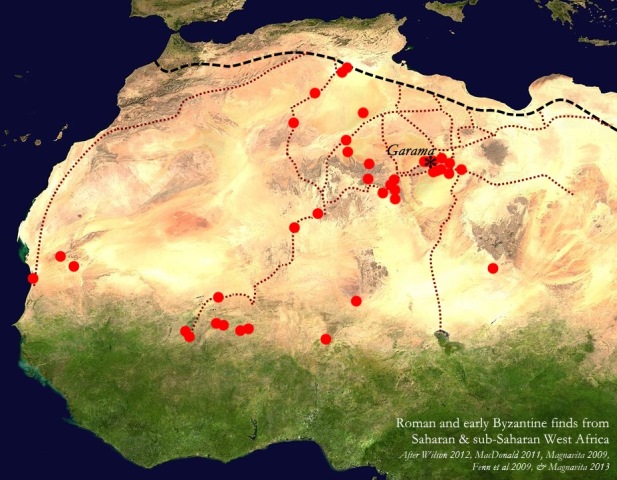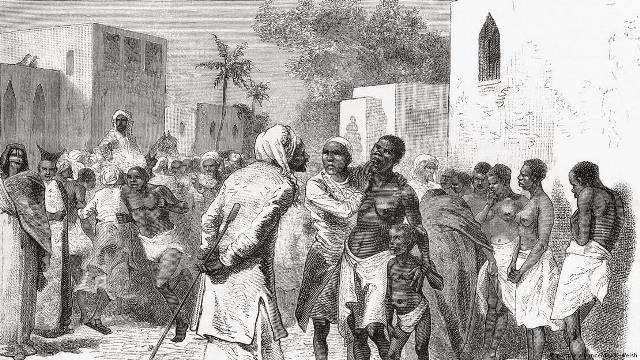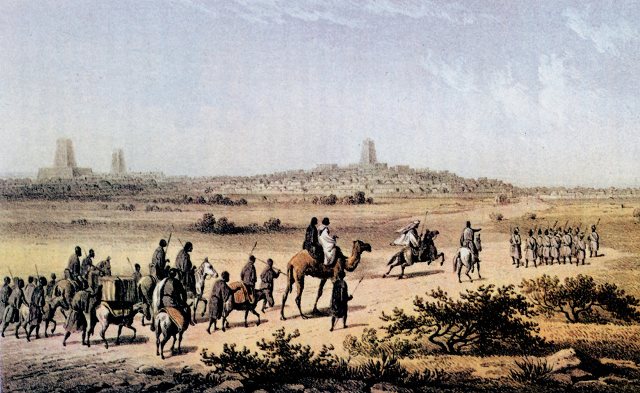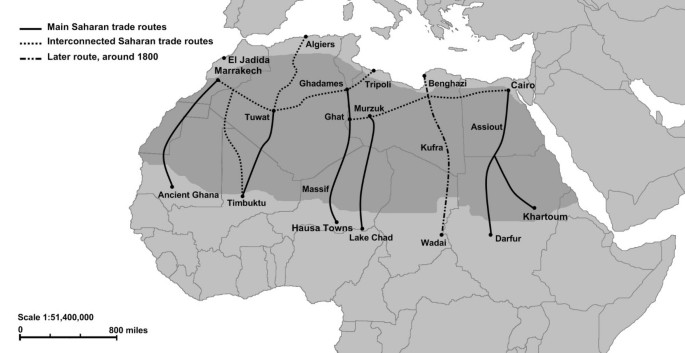Last Updated on May 9, 2023
Africans are victims of centuries and decades of slavery. This gruesome part of history has left an indelible mark on the continent. The westerners in their numbers stormed Africa and perched on the ignorance of the people. And the impact of years of slavery in Africa continues to be felt. The Trans-Saharan slave trade is another chain of enslaving Africans of many that existed.
The trans-Saharan slave trade involved transporting captives from sub-Saharan Africa to North Africa and the Middle East. It lasted for centuries, beginning in the 8th Century and reaching the late 19th century!
Although the trans-Saharan slave trade was not as well-known or researched as the trans-Atlantic slave trade, it is estimated that between 10 and 20 million Africans were enslaved during this time. This article will explore the impact of the trans-Saharan slave trade on Africa. We’ll cover the number of people affected and the long-term effects on the continent.

What is the Trans-Saharan Slave Trade?
Often called the Arab Trade, the trans-Saharan slave trade existed between the 8th and 19th centuries. It involved the transportation of slaves from sub-Saharan Africa to North Africa and the Middle East. The Trans-Saharan Slave Trade was one of the largest slave trades in history. It is estimated that between 10 and 20 million slaves were transported from Africa to the Arab world. Most of these slaves were captured in the African interior and then transported to the coast by Arab slave traders.
The trans-Saharan slave trade had a profound impact on Africa. It resulted in the enslavement and death of millions of Africans. It also led to the depopulation of large parts of Africa and the economic and social decline of the continent.
The Arab world (North Africa and the Persian Gulf) and sub-Saharan Africa connected commercially through trans-Saharan trade. It was carried out across the Sahara Desert. Gold and salt were the principal commodities traded. Gold was abundant in the western portion of Africa but scarce in North Africa. However, while salt is still essential to human societies, it was not produced in sub-Saharan Africa but was in great supply in North Africa. This gave these two areas, which were separated by a wide and hostile terrain, a basis for trading.

Early Trans-Saharan Slave Trade
The Sahara has been the site of slave trading and transportation since the third millennium BC. This was when the Egyptian king Sneferu crossed the fourth cataract of the Nile into what is now modern Sudan to seize slaves and transfer them north. The expeditions for captured soldiers who later became slaves were frequent in the ancient Nile Valley and in Africa. The ancient Egyptians captured the Nubians as slaves during periods of conquest and after winning battles.
Sub-Saharan African slaves were a major source of labor for the Garamantes. They built and maintained underground irrigation systems. Known to Berbers as foggara, they used slaves from inside their own communities. Ethiopian cave-dwellers known as Troglodytae were captured by the Garamantes and sold into slavery in the fifth century BC, according to the ancient Greek historian Herodotus.
Lepcis, a city in the early Roman Empire, had a slave market where people could buy and sell slaves from the interior of the Bantu African continent. Black slaves transported over the Sahara were traded in by Roman Carthage in the fifth century AD. The Slave trade was subject to customs taxes imposed by the empire. Due to their exotic look, black slaves appear to have been prized as domestic servants. Some historians contend that because there was such a strong demand for slaves in the Roman Empire, the scale of the slave trade during this time may have been greater than it was throughout the Middle Ages.
Middle Ages Trans-Saharan Slave Trade
Paul Lovejoy estimates that approximately 6 million African slaves were transported over the Sahara between 650 AD and 1500 AD. The historic trans-Saharan slave trade continued during the Middle Ages. During the early eighth-century conquest of North Africa, Arabs, Berbers, and other ethnic groups migrated into Sub-Saharan Africa, first traveling up the Nile Valley into Nubia, and then crossing the Sahara to reach West Africa. They were particularly interested in the trans-Saharan trade in slaves because of the continued demand for captives in the eastern Arab nations and Constantinople.
The Muslim slave dealers set themselves apart from the inhabitants of the opposite side of the Sahara. Arabs would frequently capture slaves through violent raids. After this, they would be imprisoned and forced to march dangerously through the Sahara to slave markets where they would be treated as possessions, or as tangible goods that could be purchased and sold. The main slave markets in North Africa were located in Cairo, Tripoli, Algiers, and Morocco. Public spaces, including souks, were also used for sales.
The Impact of the Trans-Saharan Slave Trade
The Trans-Saharan expansion transformed the geography of Northern and Western Africa. As more trade took new items to other locations, the region’s economy grew. But West Africa where huge commercial empires emerged, saw the most effects. The leadership of these commercial empires adopted Islam after dealings with Islamic traders, which impacted the culture of the area.
The Expansion of African Trading Powers
Between roughly 1230 and 1591, two of the richest and most powerful trade empires in West Africa, Mali, and Songhai, were at their height. These kingdoms’ wealth and strength came from the trans-Saharan trading routes. The kings of these kingdoms supported and promoted trade as a result.

The Introduction of Islam
The slave trade wasn’t all negative. One of the positives for many people is the introduction of Islam. Muslims who traded in the area helped spread Islam throughout West Africa. The monarchs of Mali had embraced Islam by the year 1300. It became the official religion in 1324 under Mansa Musa (1312–1337). Then, the Songhai kings all became Muslims. And Mali and Songhai established Islamic judicial and governing systems after their rulers converted. At first, Islam was only adopted by the affluent. Afterward, few common West Africans began identifying as Muslims in the 19th century.
West Africa Experienced the Spread of the Islamic Culture
Along with the Islamic religion, Islamic culture expanded in West Africa. Prior, traditional African religious practices continued to be the most prevalent form of worship in the majority-populated rural areas until the 19th century. This was because few efforts were made by most of the ruling classes to enforce Islamic laws on their subjects.
Later on, Arabic took over as the legal official language. It was also frequently used by wealthy tradesmen and merchants to communicate and conduct business. However, the majority of non-elites kept up their original tongues. Islamic learning got centered in places like Timbuktu and Djenne. For the purpose of learning the Quran, schools and institutions were opened. These schools’ libraries also acquired science and math information from Islamic learning institutions in North Africa and the Middle East.

The Expansion of Towns and Cities
West Africa became wealthier as a result of increased trade. Along the trans-Saharan trade network, entire towns and cities emerged to serve the requirements of traveling traders. While others evolved into market towns where traders would congregate and sell their wares. People came from West Africa to study in towns and cities with learning centers like Timbuktu and Djenne after Mali and Songhai converted to Islam.
Heightened Warfare
In West Africa, rivalry grew as wealth expanded. The fortunes of a ruler or kingdom may even be made or broken by control over the gold fields and trade routes. However, disputes over resources and authority frequently led to the internal deterioration of communities. After a civil war, the formerly powerful and prosperous Mali began to deteriorate and eventually it collapsed. It was succeeded by Songhai as the region’s dominating force, but by the end of the 16th century, it was also weakened by civil war. Invading West Africa to capture control of the region’s resources and trade, Morocco took advantage of the internal weaknesses of both empires.

The Rise in Slave Trade
Slavery in North and West Africa grew as merchants increasingly frequently shipped enslaved individuals to North Africa and wealthy monarchs in West Africa increased the number of slaves they purchased. According to some scholarly studies, trans-Saharan trade routes were used to transport up to nine million slaves. People who were in slavery were subject to a number of different servitude regimes. Slaves were used as highly skilled soldiers by West African and Egyptian rulers in their militaries. Rich families also employed slaves as domestic workers or concubines. Others mined salt or gold in North Africa or West Africa.
Family Separation and Death
During the slave trade, families and friends were forcefully separated and some died either during transportation or due to hard labor or depression. It is indeed a cruel and painful experience to have your loved one taken from you in such a way. Hence, some Africans didn’t get to survive the pain.
Before you go…
Hey, thank you for reading this blog to the end. I hope it was helpful. Let me tell you a little bit about Nicholas Idoko Technologies. We help businesses and companies build an online presence by developing web, mobile, desktop, and blockchain applications.
We also help aspiring software developers and programmers learn the skills they need to have a successful career. Take your first step to becoming a programming boss by joining our Learn To Code academy today!
Be sure to contact us if you need more information or have any questions! We are readily available.











